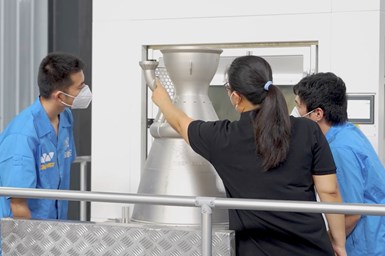Farsoon Assists in 3D Printing of Large Combustion Chamber
Farsoon’s technology also enables an accelerated design-validation cycle of 80% faster compared to conventional manufacturing processes.
Share
Read Next
Deep Blue Aerospace personnel exam as-printed combustion chamber from FS621M. Photo Credit: Deep Blue Aerospace
Farsoon technology is assisting commercial rocket launch company Deep Blue Aerospace in using industrial metal 3D printing for key components engineering.
Since 2021, Deep Blue Aerospace has had a rapid pace of development in a short time frame and completed several successful launch tests. All of which makes it only the second company in the world to succeed in all low-altitude engineering tests of reusable, liquid-oxygen-kerosene rockets, following U.S.-based spacecraft manufacturer SpaceX.
As one of the first commercial rocket manufacturers in China to use industrial metal 3D printing for key components engineering, Deep Blue Aerospace invested in Farsoon’s large-format metal system FS621M in 2022 to explore innovative manufacturing solutions for rocket engines.
“At Deep Blue, we produce over 80% of the key components in rocket engines using metal 3D printing,” says Dr. Tian Cailan, head of additive manufacturing at Deep Blue Aerospace. “Farsoon’s FS621M offers us the ability to rapidly manufacture large-sized engine parts featuring lightweight design, structural integration, improved performance and reliability, with only a fraction of the cost, labor and lead time compared to the traditional technologies.”
In 2022, Deep Blue Aerospace enhanced its batch production of single-piece, large-sized rocket engine combustion chambers using Farsoon’s FS621M system. The additive manufactured Inconel combustion chamber measures 780 mm (30.7 inches) in height and 550 mm (21.7 inches) in diameter. Major challenges included the size of the build, function integration and detail resolution.
The advanced additive manufacturing enabled new innovations from Deep Blue engineers, including consolidated design, lightweight lattice structures, and self-supported geometries. Other features (such as complex geometries with many hundreds of internal cooling ribs and channels) are designated to promote combustion efficiency of the rocket engine. The FS621M also enables economical production of oversized aerospace parts with an accelerated design-validation cycle by 80% compared to the conventional manufacturing process.
“(As) a key component of the rocket engine, the combustion chamber has to achieve the required performance, efficiency and reliability under the extreme operating conditions of heat and pressure,” Dr. Cailan says. “We are fully convinced with the high quality, fast production speed and operational stability delivered with Farsoon FS621M system. We are able to offer products that are significantly lighter, more repeatable, yet demonstrates much better properties during the functional test, which is essential to meet the demanding standards of aerospace industry.”
Related Content
-
10 Important Developments in Additive Manufacturing Seen at Formnext 2022 (Includes Video)
The leading trade show dedicated to the advance of industrial 3D printing returned to the scale and energy not seen since before the pandemic. More ceramics, fewer supports structures and finding opportunities in wavelengths — these are just some of the AM advances notable at the show this year.
-
8 Cool Parts From Formnext 2023: The Cool Parts Show #65
New additive manufacturing technologies on display at Formnext were in many cases producing notable end-use components. Here are some of the coolest parts we found at this year’s show.
-
Large-Format “Cold” 3D Printing With Polypropylene and Polyethylene
Israeli startup Largix has developed a production solution that can 3D print PP and PE without melting them. Its first test? Custom tanks for chemical storage.












.png;maxWidth=300;quality=90)



